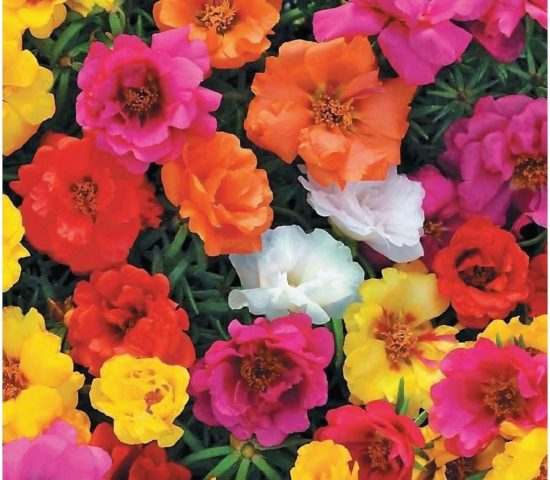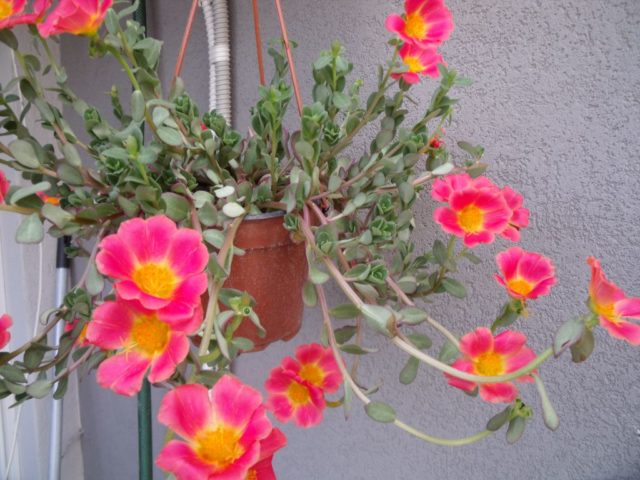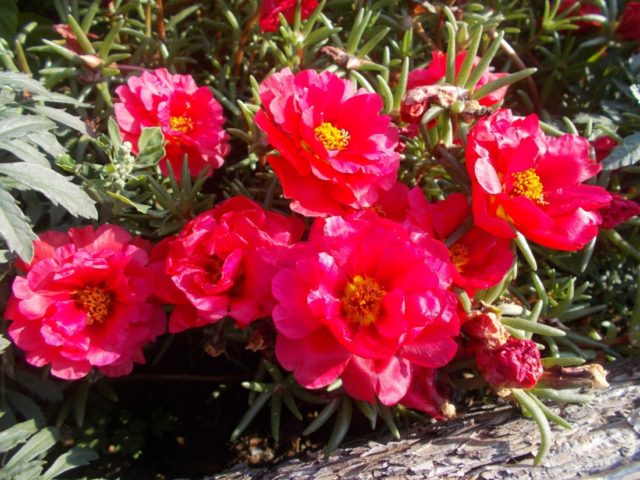Content
Purslane belongs to the category of rare plants, it has excellent external characteristics and practical value in the culinary field. It can be easily grown in any conditions, it is unpretentious. But the cultivation of terry purslane from seeds is best done in a temperate climate zone.
Description of purslane seeds with photo
Purslane is best known to people as an addition to certain types of soups, pickles and salads. The plant is divided into several types, each of which contains many vitamins and minerals.
Popular varieties include:
- Terry purslane... This species is considered to be large-flowered. The plant is of short stature. Easy to care for.
- Garden or one-year... Growing purslane from seeds allows for the appearance of small flowers. Differs in yellow colors. The stem is strongly branched. Edible, recognized as a medicinal plant.
- Purslane ampelous... This species is a hybrid. The petals can be either double or simple. The stem is branchy. More suitable for decorating alpine slides, loggias and gazebos.
- Large-flowered species... It is one year old. This is one of the first representatives to be grown in Europe. The buds come in three colors: yellow, white and red. The height of the stems does not exceed 30 cm.
Any sort of purslane has a long flowering. The buds can be pleasing to the eye until the first frost. If you plant terry purslane from seeds and grow it in the cool season, then for the winter you can remove it in a warm and well-lit place.
The nuances of growing purslane seedlings
Many people dream of growing purslane from seeds in their country house. This is not difficult. Most gardeners are of the opinion that it is better to plant a flowering culture in the form of seedlings. But in order for the whole process to go smoothly, several nuances must be taken into account.
Many experts say that sowing purslane seeds is best between February and March. In some cases, plant growth is allowed in April.
It is necessary to keep the seedlings warm. In the room, the air temperature should not fall below +22 degrees.
Planting purslane seeds for seedlings
Growing purslane from seeds for seedlings is also possible at home. If a favorable environment for the plant is created, then the first seedlings will appear after 7-14 days.
When growing seedlings, it is necessary to periodically moisten the ground - this rule is one of the main ones. The water should be separated, at room temperature. Watering is done from below.
When to sow purslane for seedlings
Many gardeners are wondering when it is better to plant large-flowered purslane and how to grow it from seeds. There is nothing difficult in this, because the seedlings are unpretentious in care.
Planting a flower crop is best done in February-March. But in order for the seedlings to grow well, it is necessary to install an ultraviolet lamp. You can plant the plant in April-May. Then the seedlings are placed on the windowsill. Thanks to the long daylight hours, the seeds will grow faster.
The choice of capacity and preparation of the soil
If you plant purslane seeds for seedlings, it will take a little time.In order for the plant to grow better, it is worth purchasing a special soil mixture in the store, as it is enriched with essential trace elements. In addition to all this, such land has good air and water permeability, looseness and lightness. It is not recommended to use black soil, compost and humus.
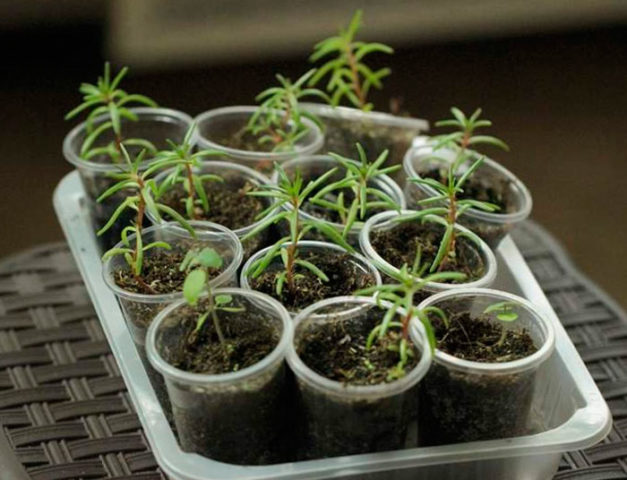
Bowls, boxes, pots or peat tablets can be used as containers.
How to plant purslane seeds
Planting purslane seeds can be done at home. The grains are small. It is not necessary to disinfect them, it is enough to mix with hot sand.
Some gardeners are of the opinion that seedlings will grow poorly without treatment with a manganese solution. Therefore, you need to make several manipulations:
- Seeds are poured into a bag of gauze folded in 2 layers.
- Then it is placed in a warm solution of potassium permanganate for 10-15 minutes.
- After that, the bag is carefully squeezed out, the seeds are dried.
Only after all the manipulations carried out can you start sowing purslane for seedlings.
The seed planting technology is as follows:
- Seeds are mixed with sand in equal parts.
- Take a pot, peat tablet, or glass that has drainage holes. Fill in a layer of gravel. Cover the top with a universal primer, preheated in the oven. Watered with settled water.
- Grains are spread on the surface of the soil. There must be a distance of at least 1 cm between the seeds.
- Then the grains are carefully introduced into the soil.
To make the seedlings grow better, they are covered with polyethylene on top.
Growing purslane seedlings at home
Sowing purslane for seedlings can be done at home. Care consists in periodic watering. This is necessary for the normal growth of seedlings.
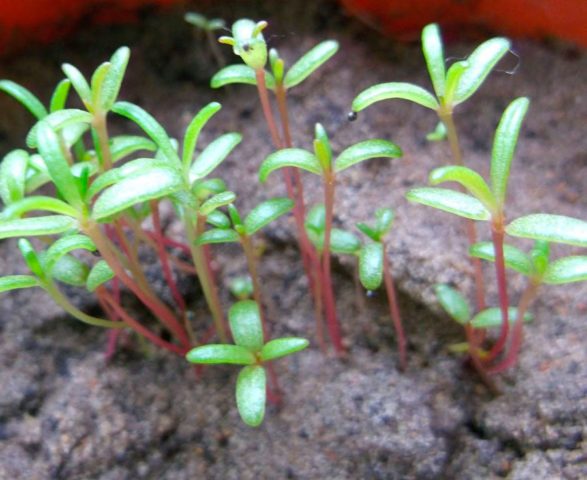
When growing such a crop, various fertilizing is not required, the soil does not need to be loosened and weeded
Microclimate
At a temperature of 35-37 degrees, the first seedlings will appear in 5-7 days. If the indicator is below 22 degrees, then the purslane may not rise.
Polyethylene or glass is used to retain heat in the soil. After the first seedlings appear, the shelter is gradually removed. First, open for a few minutes, 5-6 times a day. Each time the time increases. After about 3-4 days, the shelter is removed completely.
Watering and feeding schedule
Before the first shoots appear, the soil should be treated with a spray bottle. In order for the plant to grow better, watering is carried out daily through the pallet - this option is considered the most optimal for growing purslane.
In this case, the humidity should be moderate. It is impossible to transfuse the seedlings, otherwise it will lead to the development of fungal diseases.
Particular attention is paid to irrigation water. It is better to take the settled liquid. She will not be so tough and dirty.
Feeding purslane is optional. Some gardeners fertilize the soil with nitrogen-containing mineral fertilizers. These manipulations are carried out once every 3-4 weeks.
Picking
After the first true leaves appear on the seedlings, you can start picking. This will happen about a month after sowing.
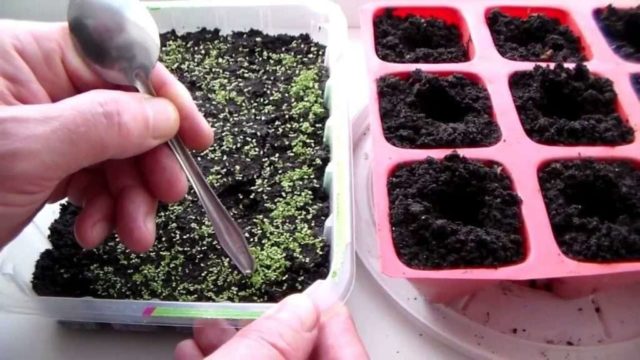
Although the plant loves warmth and light, after picking it is recommended to transfer it to the shade for a while.
Hardening
After the seedlings have acquired sufficient size, it is necessary to begin preparations for transplanting in open ground. To avoid unnecessary stress and premature death of the plant, the seedlings should be hardened.
To do this, the seedlings must be taken out to the balcony or placed on a windowsill with an open window.The main thing is that there are no drafts.
Transfer to the ground
Purslane loves the sun and warmth, so it is better to transplant in a well-lit place. The soil should be sandy, sandy loam or stony. It is important to exclude stagnant water. The plant thrives better in mountainous areas.
It is necessary to transplant a flower into the ground when the soil warms up to 20 degrees. This time usually falls in May-June. Seedlings are transplanted into pits at a distance of 15-30 cm from each other. In the first 3 weeks, purslane is watered every day, then as needed.
The plant transplant process is recommended to be carried out in cloudy weather or in the evening. So the adaptation of the flower will be easier.
Conclusion
Growing terry purslane from seeds will delight any gardener. Even a beginner can handle the plant, because the flower does not require special care. Purslane is considered unpretentious, it tolerates the adverse effects of various pests well. But there are important conditions - this is moderate watering, heat and light. Observing all the planting rules, it will be possible to achieve the appearance of a beautiful flower garden.
